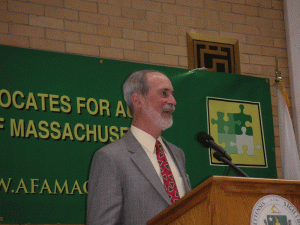Michael Forbes Wilcox
Thyme Hill
Alford, Massachusetts 01266
A pdf version of this text appears here.
Michael Wilcox was born in 1946, resided in Stockbridge, Massachusetts until age 17, and attended public schools there. He was involved in many community activities, such as Little League, Boy Scouts, and his church youth group. During high school he played (what was then called) center halfback on the school’s championship soccer team.
Wilcox grew up in an era before the concept of “Special Education” and spent nearly six decades of his life unaware of his own autism. He made friends easily; though looking back now, with the knowledge and awareness acquired late in life, those friends tended to be younger or older, or people who were shunned by others (for example, foreign students and those whom we would now recognize as having developmental disabilities). One memorable example of an older friend was Norman Rockwell, for whom he modeled as a boy of 8, and stayed friends with for many years, often dropping in at his studio to watch the artist at work.
Wilcox excelled academically in the Stockbridge school system, though he did not successfully make the transition from high school to college; going through a rough patch for many years after completing high school, before finally settling down, getting married, and attending college at night. He received a BA in Economics at age 26 (free, finally, from the Vietnam-era draft!) and an MA in Economics at age 30.
After a decade-long and very successful career in (surprise!) what was then called “data processing” (now “IT”), Wilcox shifted gears and moved into the investment business, relocating to New York City, where he lived for a dozen years, rising through the ranks of several firms and ending up as a Principal at Morgan Stanley. He was a world-renowned quantitative investment analyst, and traveled the globe to market his research to clients in all of the major financial centers. His picture once appeared on the front page of the Wall Street Journal, featured in an article about successful analysts.
Again, Wilcox made friends easily (if selectively) during his career. He was especially successful as a manager because of his ability to empathize with his employees, whom he fully supported at every turn, transforming them into productive and loyal employees. Many of these employees, looking back through the lens of autism, provided, in return, support in the form of performing many of the executive functions that were beyond his ability to handle, and covered up for some of his special needs and self-created accommodations. Getting along with his superiors was far more difficult, and he was not perceived as a “team player” — a failing which eventually put a cap on his corporate career. Wilcox then started his own consulting business, incorporated in 1992.
Wilcox began to suspect he might be autistic in early 2005, at the age of 58, after reading the book The Curious Incident of the Dog in the Night-Time. A few months later, he first learned about Asperger’s syndrome (AS), and began researching AS on the internet and by attending lectures and conferences. After about a year in denial, he self-diagnosed, and a year later, in 2007, he received a clinical diagnosis, at age 61.

